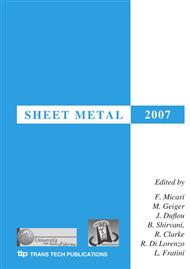[1]
X. Chen and R. Sowerby, The development of ideal blank shapes by the method of plane stress characteristics, International Journal of Mechanical Sciences, 34(1992), p.159.
DOI: 10.1016/0020-7403(92)90080-z
Google Scholar
[2]
X. Chen and R. Sowerby, Blank development and the prediction of earing in cup drawing, International Journal of Mechanical Sciences, 8(1996), p.509.
DOI: 10.1016/0020-7403(95)00068-2
Google Scholar
[3]
R. Sowerby, J.L. Duncan and E. Chu, The modeling of sheet metal stampings, International journal of mechanical science, 7(28), 1986, p.415.
DOI: 10.1016/0020-7403(86)90062-7
Google Scholar
[4]
K. Chung and O. Richmond, Ideal forming II: Sheet forming with optimum deformation, International Journal of Mechanical Sciences, (34)1992, p.617.
DOI: 10.1016/0020-7403(92)90059-p
Google Scholar
[5]
K. Chung, F. Barlat, and J.C. Brem, Blank shape design for a planar anisotropy sheet based on ideal forming design theory and FEM analysis, International Journal of Mechanical Sciences, (39)1997, p.105.
DOI: 10.1016/0020-7403(96)00007-0
Google Scholar
[6]
H. Naceur, Y.Q. Guo and J.L. Batoz, Blank optimization in sheet metal forming, Journal of Materials Processing Technology, 151(2004), p.183.
DOI: 10.1016/j.jmatprotec.2004.04.036
Google Scholar
[7]
X.S. Lu and B.W. Liang, Modelling of flange deformation of irregular drawn cups using a fluid analogy, International Journal of Mechanical Sciences, 28(1986), p.491.
DOI: 10.1016/0020-7403(86)90047-0
Google Scholar
[8]
Z.T. Zhang and B.W. Liang, Determination of blank shapes for drawing irregular cups using an electrical analogue method, 28(1986), p.499.
DOI: 10.1016/0020-7403(86)90048-2
Google Scholar
[9]
T.W. Ku and H.J. Lim, H.H. Choi, S.M. Hwang and B.S. Kang, Implementation of backward tracing scheme of the FEM to blank design in sheet metal forming, Journal of Materials Processing Technology, 111(2001), p.90.
DOI: 10.1016/s0924-0136(01)00518-0
Google Scholar
[10]
S.H. Park and J.W. Yoon, D.Y. Yang, Y.H. Kim, Optimum blank design in sheet metal forming by the deformation path iteration method, International Journal of Mechanical Sciences, 41(1999), p.1217.
DOI: 10.1016/s0020-7403(98)00084-8
Google Scholar
[11]
H.B. Shim, K.C. Son and K.H. Kim, Optimal blank shape design by sensitivity method, Journal of Materials Processing Technology, 104(2000), p.191.
DOI: 10.1016/s0924-0136(00)00556-2
Google Scholar
[12]
H.B. Shim, Determination of optimal shapes for the stampings of arbitrary shapes, Journal of Materials Processing Technology, 121(2002), p.116.
DOI: 10.1016/s0924-0136(01)01222-5
Google Scholar
[13]
K.C. Son and H.B. Shim, Optimal blank shape design using the initial velocity of boundary nodes, 134(2003), p.92.
DOI: 10.1016/s0924-0136(02)00927-5
Google Scholar
[14]
H.B. Shim, J.K. Park and Y.S. Kim, Determination of Optimal Blank Shape by Radius Vector Method, Proceedings of NUMIFORM 2004, June 13-17, Ohio State University, Columbus, Ohio, US, 712(2004), p.796.
Google Scholar
[15]
V. Pegada, Y. Chun and S. Santhanam, An algorithm for determining the optimal blank shape for the deep drawing of aluminum cups, Journal of Materials Processing Technology 125-126 (2002), p.743.
DOI: 10.1016/s0924-0136(02)00382-5
Google Scholar
[16]
H. Shim, J.K. Lee and Y.S. Kim, Automatic generation of initial shape for initiation of optimal blank design sequences, International Conference on Technology of Plasticity, October 9-13, 2005, Verona, Italy.
Google Scholar
[17]
Y.H. Lu, C.L. Li and S.W. Lo, A study of the optimum blank for square cup drawing using the streamline method, Journal of Materials Processing Technology 110 (2001), p.146.
DOI: 10.1016/s0924-0136(00)00856-6
Google Scholar
[18]
H. Palaniswamy, G. Ngaile and T. Altan, Finite element simulation of magnesium alloy sheet forming at elevated temperatures, Journal of Materials Processing Technology, 146(2004), p.52.
DOI: 10.1016/s0924-0136(03)00844-6
Google Scholar


